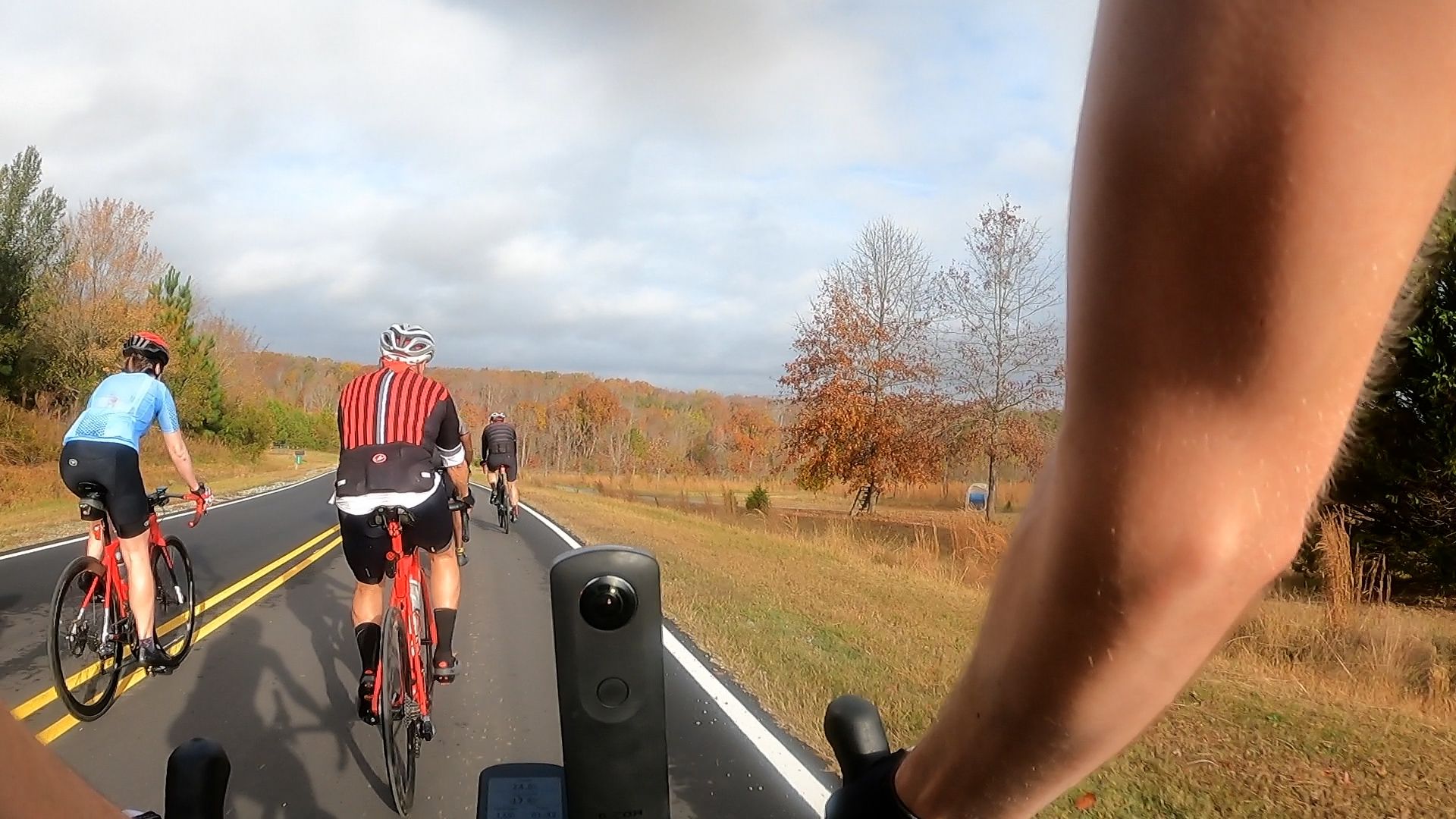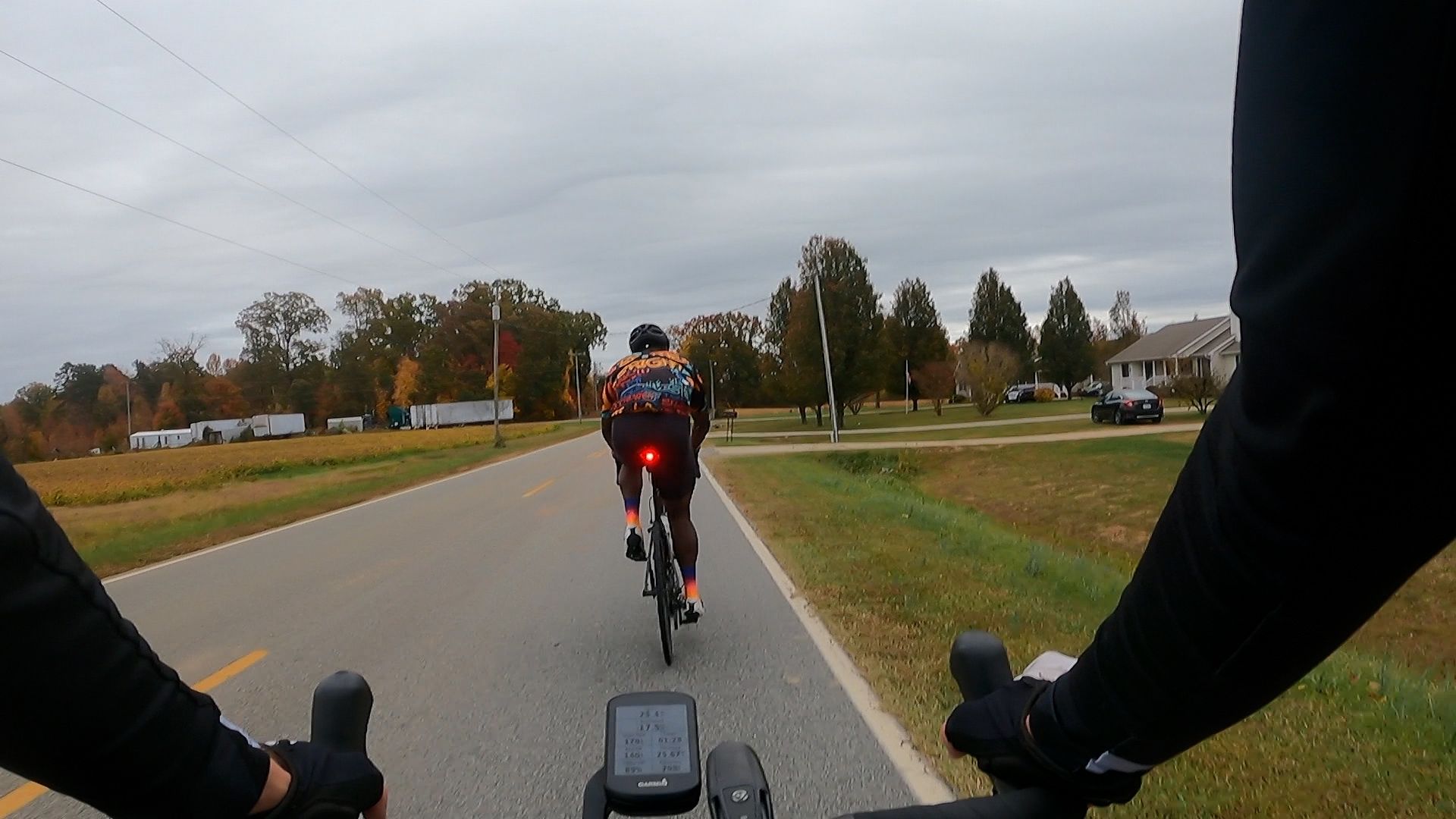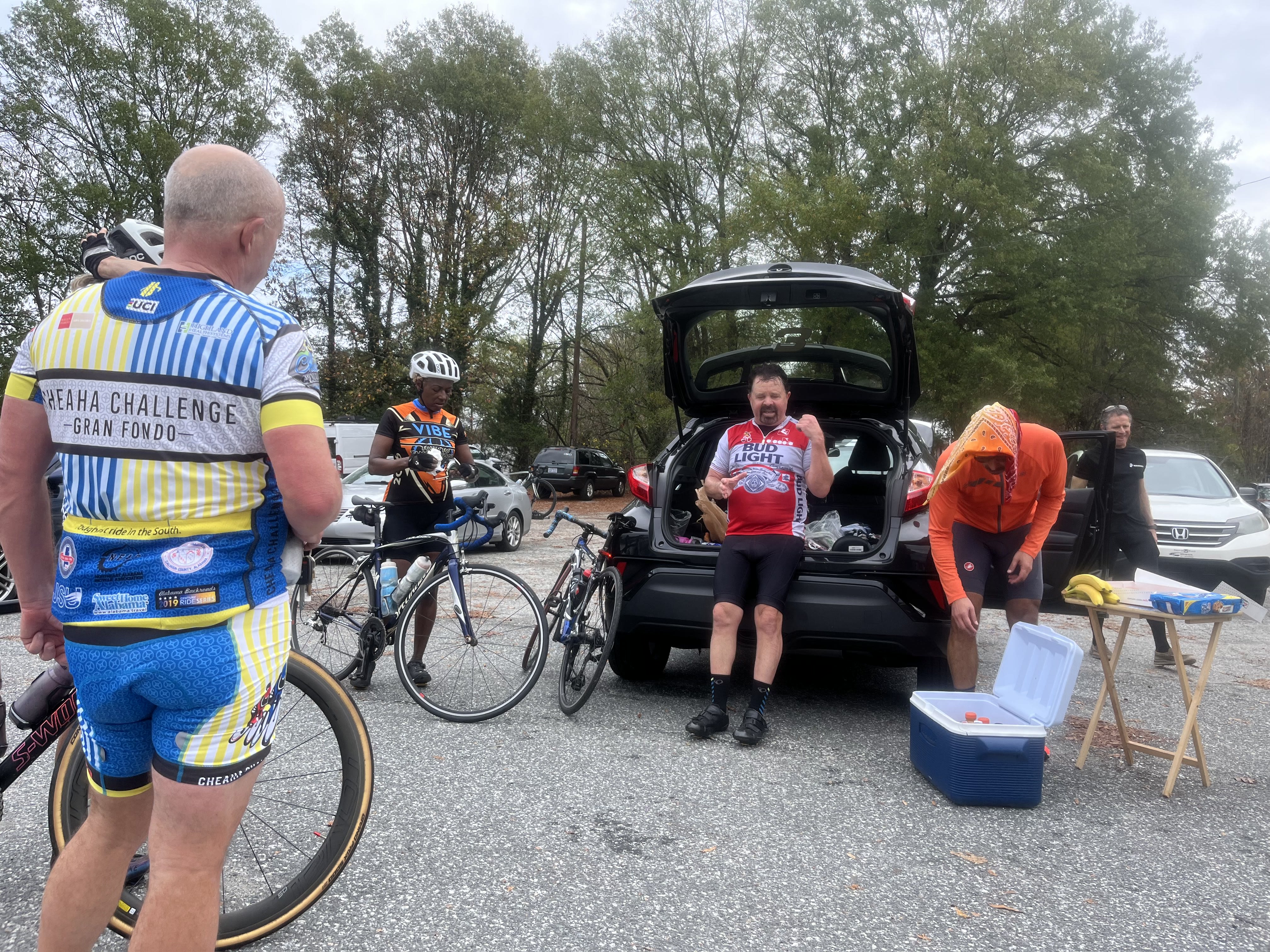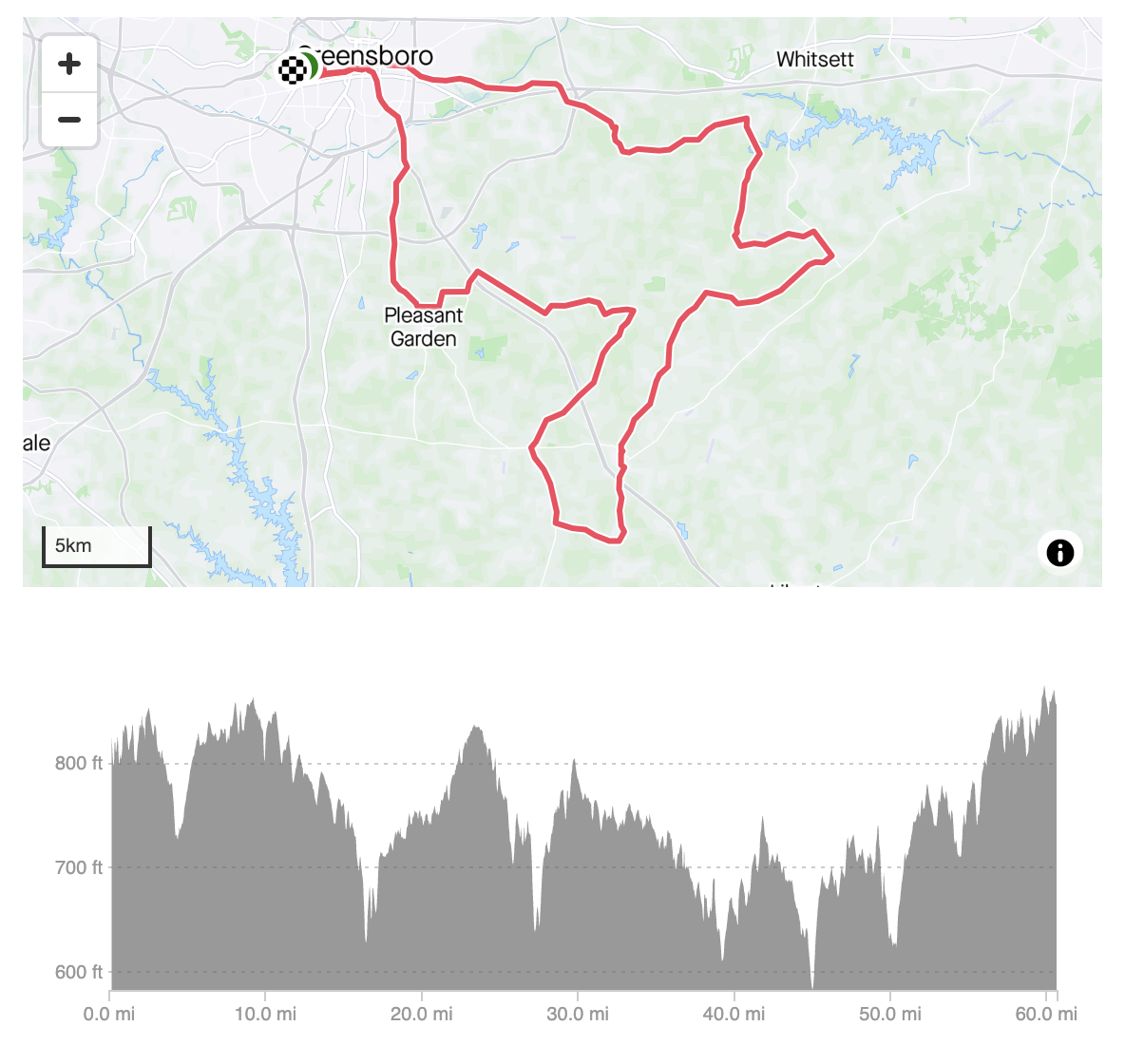Down to Ride
I spent my November weekends with a group of bicyclists in Greensboro, chronicling the cars, crazy dogs, camaraderie and cycling.

My Saturday morning begins at 6:30 a.m. All my tools, camera equipment and water bottles are already in a bag. The only thing I need to do is put on my lycra and take my bike out to the car.
Those two simple tasks consume 30 minutes. It has not been my finest morning.
Lycra: Another word for spandex. Cyclists wear this skin-tight clothing while on the bike to become more aerodynamic.
The air is muggy and the roads slippery; when I reach the Greensboro city limits, raindrops begin to fall. But the rain stops as suddenly as it starts, and when I pull into an unpaved parking lot adjacent to a combination dive bar-laundromat, I’m relieved to see a couple other cyclists taking bikes out of their cars.
This is Suds and Duds, a weekly group bicycle ride named for the dive bar-laundromat. They’ve been rolling out at 8 a.m. on Saturday almost every week for the past two years – on rare occasions the weather warrants a cancelation – under the leadership of John Erickson.
On this particular day, the group is small, made up of about a dozen riders. Erickson theorizes the weather has kept a lot of regulars away. It makes his job easier, though, he says.
“Cyclists are like eighth graders,” Erickson, a middle school teacher, tells me with a hint of sarcasm. “They never listen to anything.”
The ride rolls out a few minutes late – at 8:06 a.m., to be precise. To a cyclist, the scene would be familiar and comforting: the sounds of GPSes turning on, shoes clipping into pedals and a group looking both ways before filtering out onto the streets of Greensboro.
But as the cyclists roll out, they have to be cautious; dozens of crashes involving bikes and cars occur in the Piedmont Triad every year. Click here to see the data.

The Suds and Duds group rolls out onto Walker Avenue in Greensboro on November 5, 2022.
Join the ride in 360° below
“If you’re stronger, pull longer.”
There’s plenty to keep the group occupied on the way out of Greensboro, even as they politely banter. The roads are wet and, in many places, covered in potholes. As the group picks up speed, two pacelines form.
Rider communication, with both words and hand signals, becomes crucial. The leaders point down at the ground to warn those behind them of potholes, roadkill and gravel. In return, the back of the group watches for passing cars and sends forward observations.
Erickson sits in the back. As the group leader, his job is to keep the group together and be particularly conscious of the weaker riders’ wellbeing.
“I’m always worried about the back,” he tells me. “A lot of rides when I was racing … we were always trying to drop people, we were trying to get away. Here, I want to keep the group together.”
Case-in-point, as the group heads out of town, one rider drops their chain and has to pull off the road. As the rest of the group rolls on, Erickson stays behind to help.
“Don’t kill the hill!” he shouts to the parting riders as they head up a steady grade.
The hill, on Old U.S. 421 southbound, is where the friendly chatter quiets down. As soon as Erickson and the other rider catch up, it’s time to focus. Turning south on Pleasant Garden Road, the pullers now have to fight a fierce headwind. Every few miles, the front two riders rotate to the back and are replaced by a pair of fresh (or as fresh as can be expected) legs.
Pulling hurts. I take my first turn at the front heading due south toward Pleasant Garden. The wind remains unforgiving, not that I can think about it. My eyes are fixed on the pavement in front of me. My only concern is to keep my legs moving as fast and as powerfully as possible, pain be damned.
After about 10 minutes, I tap my back and pull off to the side. Two more riders replace me and the man leading the other paceline. Comfortably protected by our new human windshields, he and I strike up a conversation about our bikes (we’re both riding a Specialized, though his is significantly more expensive than mine).
Erickson later tells me this guy, John Davenport, is one of the faster riders in the group. This 60-mile ride with the pace at a shade under 20 miles an hour, Erickson says, is easy for Davenport, but his contribution as a puller is valuable.
“If you’re stronger, pull longer,” Erickson said. “John stayed there a long time today; that was fine. I'd rather him do that than try to blow the ride up.”
The cycle of cycling continues. I’m at the front again a few miles later, then back in the pack. The order of the paceline changes at stop signs and stop lights – Davenport usually at the front, Erickson always at the back – the leaders dragging everyone else up and down the rolling hills until we reach the unincorporated community of Julian.
“This is our store stop!” Erickson yells as he sprints to the front of the group, peering forward as we come to a Y-intersection with a gas station. With no cars coming, the group pulls in and puts their bikes against the walls. We’ve done 27 miles in 1:32:27.
Paceline: A formation of cyclists that allows riders in the back to ride without wind resistance while riders at the front fight the wind.
Drop: A cyclist who can't keep up with the group's pace is considered "dropped" and left to fend for themselves. Group rides are often "no-drop" rides.
Dropped chain: when attempting to shift gears, a misaligned chain will sometimes fall off the front gears connected to the pedals. This usually isn't dangerous, but often requires the cyclist to get off the bike and manually put the chain back on the chain ring.
Pullers: The riders at the front of the paceline. They "pull" the group by taking the brunt of the wind and removing the burden from everyone behind them.
Specialized: A popular American bike brand. A low-end road bike made by Specialized costs around $1,000, while the most expensive publicly available models retail for over $14,000.
John Erickson addresses the Suds and Duds group members during their store stop in Julian, North Carolina, on November 5.

Staying safe
The ride has been quaint to this point. Cars have generally given us a wide berth as they pass and been patient as they wait to overtake. It helps that it’s Saturday morning and there’s not much going on. Plus, there’s safety in numbers.
Anthony McDonald, a cyclist in Burlington, does most of his riding either solo or in smaller groups. As the two of us ride together on a different day, without a posse of other cyclists surrounding us, he and I squeeze ourselves as close to the edge of the road as possible.
Without the luxury of a large group, solo cyclists often feel more pressured by drivers making close overtakes, McDonald says. Occasionally, it can feel intentional.
“Every now and then, you have somebody get too close,” McDonald said. “It might be a diesel driver; they’ll try to coal roll you. That’s probably the worst part.”
According to data from the North Carolina Department of Transportation, there were 1,633 crashes in the counties within the Piedmont Triad involving a car and a bike between the beginning of 2007 and the end of 2021.
Of those 1633 crashes, only 641 reported the number of bikes involved. Only 11 crashes had more than one bike, and none had more than two. When the 2022 data is added in, it will include a crash of one of McDonald’s friends, who was hit by an 18-wheeler while riding solo.
Even though McDonald's friend has recovered and is back to riding long-distance, there is anxiety among cyclists when going at it alone. Crashes like that add to the draw of Suds and Duds, Erickson says. People like the safety of being in a bigger group.
“Safety is the biggest (concern),” Erickson said. “And that’s one of the reasons we do this. And it’s hard … that’s why we try to make it fun.”
Rolling coal: Spewing partially combusted diesel fumes, often with intent to annoy cyclists and pedestrians. The practice is illegal in North Carolina if the fumes are emitted for more than five seconds at darker than 20% opacity, but the law is hard to enforce.
A few miles after the store stop, there is indeed an incident with a car. As the group prepares to turn left and head west back toward Greensboro, a driver in a white SUV gets up close and yells something not too kind before flipping us off. One of the riders returns the middle finger.
Things like that are all too common on the roads, Erickson says. Part of his job as the ride leader is to keep things from getting too contentious.
“I've seen some bad situations out here and some confrontational ones,” he said. “And even if we're right, you don't want to be dead right.”
There are more hazards than just cars; at one point, a rider slips on the wet painted line on the side of the road while turning and scrapes his arm up. The group stops to make sure he is alright. After a minute, he’s back in the saddle and at the front of the group, temporarily setting the pace while he gets up to speed.
Accidents like that are destined to happen when the road is slippery, Erickson reminds everyone. “Stay off the paint!” he shouts as we make our next turn.
There’s also the threat of dogs along the road in rural areas. On one of my later rides with the Suds and Duds group, a pair of angry terriers come at the group, unfazed by the two dozen cyclists. They back off only after being yelled at by a chorus of out-of-breath riders.
When the dogs don't back down, sometimes the only option is to pedal as hard as you can. McDonald tells me on our ride together about being chased down the road by a canine while riding with a buddy.
“We were on a slight hill, maybe a 2% hill,” McDonald said. “We were on the way back, so we were a little spent … we’re going up this hill and I hear the bark.”
McDonald and his partner sprinted up the hill, but the dog continued chasing them. As they turned off the road, they sprayed it with their water bottles, which was enough to get it to leave them alone.
“Scared the crap out of me, honestly,” McDonald said.
The other hazard to riders is wind; a crossbreeze can blow cyclists off their line and potentially endanger anyone next to them or put them in the way of traffic if they’re riding solo. The wind during the Suds ride is friendly and predictable, however. After fighting a headwind all the way to Julian, we ride at a brisk 22 miles an hour without expending a ton of effort on the way back into Greensboro.
The ride ends where it began, with one more rider than before; a late-arriver did the route in reverse and joined us when we crossed paths about 40 miles in. One of the roads we take as we head back is Old Julian Road, which cuts northeast from the small community toward Burlington. Erickson tells me that’s his favorite road to ride in the area.
“It’s undulating and it’s low traffic and it’s a smooth surface,” he says. “It’s like a fresh jar of peanut butter.”

Anthony McDonald rides along a country road on October 30. McDonald does most of his riding solo or in smaller groups, which he says can be risky.
2% hill: Cyclists often refer to a hill by its average gradient. The overall difficulty of a hill varies depending on its length and the rider's level of fitness.
Cyclists in the Suds and Duds group wait to get back on the road while one rider makes a roadside repair on November 12.

Crashes and camaraderie
The next weekend, I’m back at Suds and Duds, talking before the ride to Josh Cates, who is riding a particularly snazzy Trek and wearing light blue shoes. Erickson introduces me to him and tells me he is a former pro racer.
I ask him if he’s planning on doing a lot of pulling today. “Depends on who shows up,” he replies nonchalantly.
We roll out with the group and pretty quickly it becomes obvious that he’s indeed going to be doing a lot of pulling today. As we head west along Market Street toward Piedmont Triad International Airport, he easily answers my questions while I strain my legs to keep pace at the front of the group. We talk about his getting into cycling after being a professional climber, his career and his much more relaxed post-professional cycling life.
Crashes bookended his career. In July 2011, he was hit by a car on a solo ride while making a turn north of Greensboro, a nearly lethal baptism to his professional cycling life. Almost exactly two years later, while on vacation near Myrtle Beach, he was hit by a car again and tore his meniscus.
Even now, Cates says almost every ride involves some sort of dangerous situation on the road involving a vehicle. He’s pretty used to it by now and says it’s best to not piss off the driver.
“Just a smile and a wave, usually that’s what you should do,” he says.
We pull the group pretty hard despite some bad luck with traffic lights, averaging around 19 miles per hour for the first nine miles of the ride. As we near the turn off Market Street, Cates tells me he usually takes it pretty easy on Suds and Duds. Often, he says, he’ll shift into the small chain ring, just to make sure he’s not dropping anyone.
I give him a bit of a blank stare. “So you’ve been in the small ring this whole time?”
“Yep,” he says with a smile.
That’s enough to deflate me, and I spend the next 10 miles in the middle of the pack, talking to the group – it’s almost twice the size of last week. There’s a bit of sluggishness at the start of the ride, with a couple regulars dropping off and heading home, but by the time we get out of the city and onto the country roads, the pace picks up and there’s camaraderie again.
Erickson has stressed to me that there’s a “good mix” of people in the group usually, which I find is true after talking to everyone. People tell me their day jobs: teacher, professor, IT, vice president of a sock company. The group is mostly men, but of the two dozen riding today, there are four women. Diversity in size, too: I’m one of the biggest riders in the group at 6’3” and 170 pounds, but I spend a couple miles pulling next to an Elon University professor over a foot shorter than me.
There’s several different skin colors represented. A variety of ages, too; I’m easily the youngest at 21, while the oldest members of the group are retirement age. Not to mention another form of diversity: bike brands. A lot of Specializeds and Treks, a couple Canyons, a smattering of Italian names, like Colnago and Bianchi.
As Rule No. 4 of the Velominati’s many rules for cyclists reads, “it’s all about the bike.” But on Saturday mornings, when they meet in front of the “historic” dive bar-laundromat and shred the pavement for four hours, it’s about more than the bike for the Suds and Duds riders.
It’s about each other.
“We're out there, we're fighting the wind, the rain, the cold weather, potholes, cars, crazy dogs; everything else is going against us,” Erickson said. “Last thing we need to do is be arguing with ourselves.”
Trek: Another popular American bicycle brand.
Small chain ring: Most road bikes have two chain rings to shift between: a tougher, faster big chain ring and an easier, slower small chain ring. The big ring allows a rider to put more power into their bike, but requires more effort than the small ring.

John Erickson (center) talks shop with a few other cyclists after the Suds and Duds ride on November 12, 2022.


